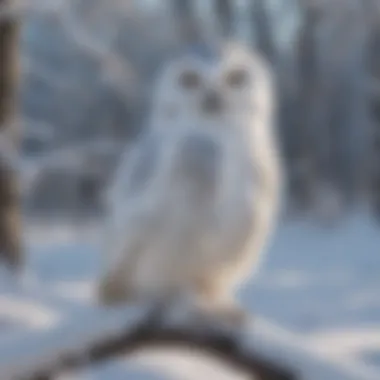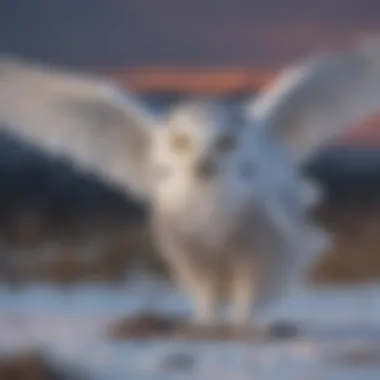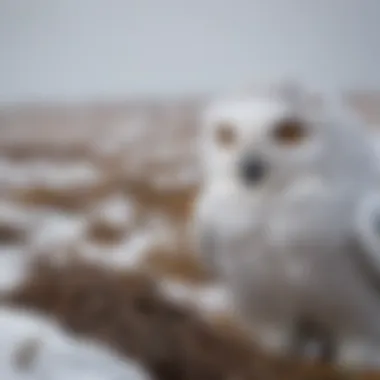Discover the Enchanting Odyssey of Snowy Owl Migration


Nature Topic Overview
Snowy owl migration is a wondrous spectacle that unfolds with precision and determination. These majestic birds embark on an arduous journey, crossing vast distances in search of sustenance and suitable nesting grounds. Their unique adaptations and innate resilience enable them to brave the challenges that await them along the way. Understanding the intricacies of snowy owl migration sheds light on the marvels of nature and the importance of preserving their habitats.
Fun Facts and Trivia
-Snowy owls are known for their striking white feathers, perfectly adapted for blending into the snow-covered landscapes of their Arctic homelands.**** -These birds have acute vision, allowing them to spot even the tiniest movements from great distances to hunt with precision. -Despite their name, snowy owls do not exclusively dwell in snowy regions; they also inhabit grasslands and tundra areas. -Young snowy owls have dark plumage which gradually transforms into the iconic white feathers as they mature.
Wildlife Explorations
-Exploring snowy owl migration opens a window to understanding other fascinating Arctic species, such as Arctic foxes and lemmings that play pivotal roles in the ecosystem. -Habitats frequented by snowy owls are rich in diverse flora and fauna, including hardy plants like Arctic moss and lichens that thrive in extreme conditions.**** -Interactive features like quizzes can challenge young minds to identify different animals and plants associated with the snowy owl's habitat.
Environmental Awareness
-Preserving the habitats of snowy owls is crucial for maintaining ecological balance in fragile Arctic ecosystems.**** -Children can contribute to conservation efforts by learning about sustainable practices and spreading awareness about the importance of protecting wildlife habitats. -Tips on reducing waste, conserving energy, and supporting organizations dedicated to wildlife conservation can empower young individuals to make a positive impact on the environment.
DIY Nature Activities
-Engaging in nature-inspired activities can foster a deeper connection with the natural world for children.**** -Hands-on experiments like creating bird feeders or planting native flowers can provide valuable insights into the ecosystem's intricate workings. -Encouraging outdoor explorations, such as birdwatching or nature walks, can instill a sense of wonder and appreciation for the beauty of the environment around us.
Introduction to Snowy Owls
Snowy Owls, originating from the Arctic regions, are majestic birds renowned for their graceful presence and unique adaptations that enable them to thrive in harsh environments. Within the context of this article, delving into the realm of Snowy Owls provides a crucial foundation for understanding their remarkable migration patterns, behaviors, and significance in the ecological landscape. By exploring the intricate details of Snowy Owls, ranging from their physical attributes to their diet and habitats, readers gain a profound insight into the world of these enigmatic creatures.
Overview of Snowy Owls
Physical Characteristics


Snowy Owls exhibit distinctive features, including their predominantly white plumage with dark markings, fluffy feathers that insulate them from extreme cold, keen yellow eyes for superior vision, and a wingspan of up to five feet enabling efficient flight. These physical characteristics play a pivotal role in their survival, allowing them to camouflage effectively in snowy landscapes, spot prey from great distances, and soar through the air with agility. The robust build of Snowy Owls embodies strength and resilience, essential in their rigorous migratory journeys.
Habitat
Snowy Owls primarily inhabit Arctic tundra and open expanses, seeking areas with minimal vegetation for hunting and nesting. Their choice of habitat reflects their adaptation to icy terrains, where they establish nests on elevated sites to survey their surroundings and protect their young from predators. The vast, desolate landscapes of the Arctic serve as the perfect backdrop for Snowy Owls to thrive, utilizing their environment to fulfill their hunting and reproductive needs.
Diet
Snowy Owls are formidable predators, preying mainly on lemmings, rodents, rabbits, and occasionally birds. Their carnivorous diet sustains their sizable bodies and energetic demands, ensuring their survival in harsh Arctic conditions. By showcasing a preference for small mammals, Snowy Owls contribute to regulating rodent populations, exerting an ecological influence beyond their individual presence.
Significance of Snowy Owls
Cultural Symbolism
In various cultures, Snowy Owls symbolize wisdom, foresight, and adaptability, revered for their silent flight and nocturnal prowess. Their symbolic significance transcends geographical boundaries, embodying notions of stealth, intuition, and mystery. Integrating Snowy Owls into folklore and art captures the essence of their mystical allure, bridging the gap between human imagination and the natural world.
Ecological Importance
Snowy Owls hold ecological significance as apex predators in Arctic ecosystems, regulating prey populations and maintaining environmental balance. Their predatory role influences community dynamics, preventing overpopulation of herbivores and safeguarding vegetation. By understanding the ecological interplay involving Snowy Owls, conservation efforts can be tailored to preserve their habitats and contribute to biodiversity conservation.
Understanding Migration
Definition of Migration
- Basic Concept: The Basic Concept of migration is the fundamental movement of individuals from one location to another in response to changing environmental conditions. In the context of snowy owls, this phenomenon is essential for their survival as they migrate to regions with abundant prey and suitable nesting sites. Their ability to navigate long distances with precision showcases the remarkable instinctual behavior of these birds. Despite facing challenges such as adverse weather and predation risks during migration, snowy owls demonstrate resilience and adaptability, making migration a vital aspect of their life cycle.
- Purpose: Migration serves a definitive Purpose in the lives of snowy owls, enabling them to fulfill their biological needs efficiently. The Purpose of migration for snowy owls includes accessing new food sources, avoiding harsh winter conditions, and engaging in breeding activities. This cyclic movement ensures the perpetuation of the species and the maintenance of ecological balance within their habitats. Understanding the Purpose of migration provides valuable insights into the evolutionary strategies adopted by snowy owls to thrive in diverse environments.
Types of Migration
- Seasonal Migration: Seasonal Migration plays a pivotal role in the life of snowy owls, influencing their migratory patterns based on changing seasons. During winter, snowy owls migrate to southern regions in search of prey, while in summer, they return to their breeding grounds in the Arctic. This cyclical movement aligns with the availability of food resources and optimal breeding conditions, illustrating the adaptive nature of snowy owl migration.
- Breeding Migration: Breeding Migration signifies the significant journey undertaken by snowy owls to establish nesting territories and raise their young. This phase of migration involves selecting suitable sites for breeding, courtship displays, and rearing offspring until they become independent. The careful orchestration of behaviors related to breeding migration reflects the investment snowy owls make in ensuring the survival of future generations.
- Irregular Migration: Irregular Migration introduces variability into the migratory patterns of snowy owls, reflecting the flexibility and adaptability of these birds in response to environmental changes. Factors such as food availability, climatic fluctuations, and human disturbances can influence the irregular migration routes chosen by snowy owls. Despite the unpredictability associated with irregular migration, snowy owls demonstrate remarkable resilience in adjusting their movements to overcome challenges and optimize their chances of survival.


Challenges Faced During Misstyion
The section on 'Challenges Faced During Migration' delves into the arduous journey that snowy owls undertake, highlighting the obstacles and risks they encounter during their migration. Snowy owl migration itself is a challenging and perilous feat that showcases the resilience and adaptability of these majestic birds. Understanding the challenges they face sheds light on the importance of conservation efforts to ensure their survival.
Predation Risks
Natural Predators
Natural predators pose a significant threat to the snowy owls during migration. The harsh reality is that various predators lurk along the migration routes of these birds. From Arctic foxes to wolves, these carnivores see the migrating owls as potential prey. The stealth and agility of these predators make them formidable threats to the snowy owls, adding another layer of complexity to their already challenging journey. Despite these dangers, these predators play a crucial role in maintaining the balance of the ecosystem.
Human Interference
Human interference is another pressing issue that contributes to the challenges faced by snowy owls during migration. Encroachment on their habitats, pollution, and climate change are all factors that disrupt the natural migratory patterns of these birds. The increasing human presence in previously undisturbed areas has led to conflicts with wildlife, including snowy owls. Additionally, the use of pesticides and urban development further escalates the threats faced by these magnificent creatures. Addressing human interference is essential to safeguarding the snowy owl population and preserving their migratory routes.
Environmental Obstacles
Weather Conditions
The unpredictable nature of weather conditions poses a considerable obstacle to snowy owl migration. Storms, extreme temperatures, and changing climatic patterns can disrupt their journey, forcing them to alter their flight paths or seek shelter. Snowy owls, adapted to the harsh Arctic climate, may struggle to cope with the variability of weather conditions encountered during migration. Understanding the effects of weather on their migratory behavior is vital in formulating conservation strategies to mitigate these risks.
Habitat Loss
Habitat loss, primarily due to human activities, has emerged as a critical environmental obstacle for snowy owls during migration. The destruction of their nesting sites and foraging grounds reduces the resources available to these birds during their journey. As natural habitats continue to diminish, snowy owls are forced to contend with fragmented landscapes and limited food sources. Conserving and restoring their habitats is imperative in ensuring the successful continuation of snowy owl migration routes and preventing further decline in their population.
Adaptations for Migration In considering the captivating journey of snowy owl migration in this article, it is imperative to delve into the critical role of adaptations for migration. These adaptations are essential mechanisms that enable snowy owls to navigate vast distances in search of sustenance and breeding grounds. By understanding the specific elements and benefits of these adaptations, we gain valuable insights into the remarkable ways in which these majestic birds have evolved to survive and thrive during their challenging migration. Exploring adaptations for migration provides a deeper understanding of the resilience and efficiency of snowy owls in their journey across continents and climates.
Physical Adaptations


Feather Structure Snowy owls possess a remarkable feather structure that plays a pivotal role in their ability to withstand varying environmental conditions during migration. The key characteristic of this feather structure lies in its insulation properties, which enable snowy owls to regulate their body temperature in extremely cold environments. This adaptation is a popular choice for this article due to its significance in the survival of snowy owls amidst harsh weather conditions. The unique feature of snow owl feather structure is its lightweight yet insulating nature, offering advantages such as enhanced flight performance and energy conservation. Despite its advantages, the feather structure can also pose challenges in wet conditions, potentially reducing its insulation properties.
Flight Efficiency The flight efficiency of snowy owls is another crucial aspect of their physical adaptations for migration. Their flight efficiency allows them to cover long distances with minimal energy expenditure, making their migration journeys more sustainable. A key characteristic of this efficiency lies in the aerodynamic design of snowy owl wings, which enable swift and silent flight. This adaptation is a beneficial choice for this article as it underscores the incredible aerial abilities of snowy owls during migration. The unique feature of flight efficiency is its contribution to reducing fatigue and maximizing hunting success, thereby ensuring the overall success of the migration process.
Behavioral Adaptations
Hunting Strategies The hunting strategies of snowy owls play a vital role in their overall migration success by securing essential food resources along their journey. The key characteristic of these strategies lies in the careful observation and swift execution of hunting techniques, which allow snowy owls to capture prey efficiently. This adaptation is a popular choice for this article due to its critical importance in sustaining snowy owl populations during migration. The unique feature of hunting strategies is their adaptability to different prey species and hunting environments, providing advantages such as nutritional diversity and adaptability to changing conditions. Despite its advantages, hunting strategies may pose disadvantages in situations of prey scarcity, challenging snowy owls to modify their hunting approaches.
Nesting Behaviors Nesting behaviors are fundamental behavioral adaptations that ensure the continuation of snowy owl populations across generations. The key characteristic of these behaviors lies in the meticulous nest construction and parental care provided by snowy owls to their offspring. This adaptation is a beneficial choice for this article as it highlights the nurturing and protective instincts of snowy owls during the breeding season. The unique feature of nesting behaviors is their role in fostering strong family bonds and ensuring the survival of young owls in demanding environments. Despite its advantages, nesting behaviors may present challenges in instances of habitat disturbance or predation, emphasizing the need for adaptive responses to ensure reproductive success.
Conservation Efforts
Conservation efforts play a crucial role in preserving the fragile balance of nature, ensuring the survival of various species, including the magnificent snowy owls. In the context of this article, the focus is on two specific elements of conservation efforts: protecting habitats and reducing human impact. By dedicating significant attention to conservation efforts, we aim to shed light on the proactive measures needed to safeguard these majestic birds and their ecosystems.
Importance of Conservation
Protecting Habitats
Protecting habitats is a cornerstone of conservation efforts, serving as a fundamental pillar in maintaining biodiversity. The meticulous preservation of natural habitats ensures that snowy owls have undisturbed nesting grounds and ample food sources. The key characteristic of protecting habitats lies in its ability to create sanctuaries where these birds can thrive undisturbed. This proactive approach is a beneficial choice for this article as it highlights the critical role of habitats in supporting wildlife populations. Despite some disadvantages such as high costs and regulatory challenges, the unique feature of protecting habitats is its direct impact on species survival, making it a vital component of wildlife conservation.
Reducing Human Impact
Reducing human impact is another vital aspect of conservation efforts, aiming to mitigate the negative consequences of human activities on the environment. By minimizing disturbances such as habitat destruction and pollution, efforts to reduce human impact help secure a safer world for snowy owls and other wildlife. The key characteristic of reducing human impact is its emphasis on sustainability and coexistence with nature. This approach is a popular choice for this article as it underscores the need for responsible interactions with the environment. Despite challenges like resource limitations and cultural practices, the unique feature of reducing human impact is its potential to foster harmonious relationships between humans and ecosystems, offering long-term benefits for all.
Community Involvement
Community involvement is crucial in shaping successful conservation efforts, mobilizing collective action towards environmental protection. Within this article, the focus is on two specific aspects of community involvement: citizen science initiatives and educational programs. By engaging communities in conservation activities, we can foster a deeper appreciation for nature and empower individuals to take an active role in preserving biodiversity.
Citizen Science Initiatives
Citizen science initiatives involve ordinary people in scientific research, expanding the reach of data collection and monitoring efforts. By actively involving citizens in observing snowy owl populations and habitats, these initiatives contribute valuable information to conservationists. The key characteristic of citizen science initiatives is their ability to bridge the gap between scientific expertise and public participation. This approach is a beneficial choice for this article as it showcases the power of community collaboration in wildlife conservation. Despite some challenges like data accuracy and volunteer retention, the unique feature of citizen science initiatives is their capacity to democratize science and inspire a sense of ownership in environmental stewardship.
Educational Programs
Educational programs are instrumental in raising awareness and building knowledge about conservation issues among diverse audiences. By integrating conservation education into formal and informal settings, these programs empower individuals to make informed decisions that benefit the environment. The key characteristic of educational programs is their role in nurturing environmental literacy and fostering a conservation mindset. This popular choice for this article highlights the transformative power of education in cultivating a sustainability-oriented society. Despite hurdles like limited resources and access, the unique feature of educational programs is their potential to instill a sense of responsibility and foster a culture of conservation within communities, laying the foundation for a greener future.







